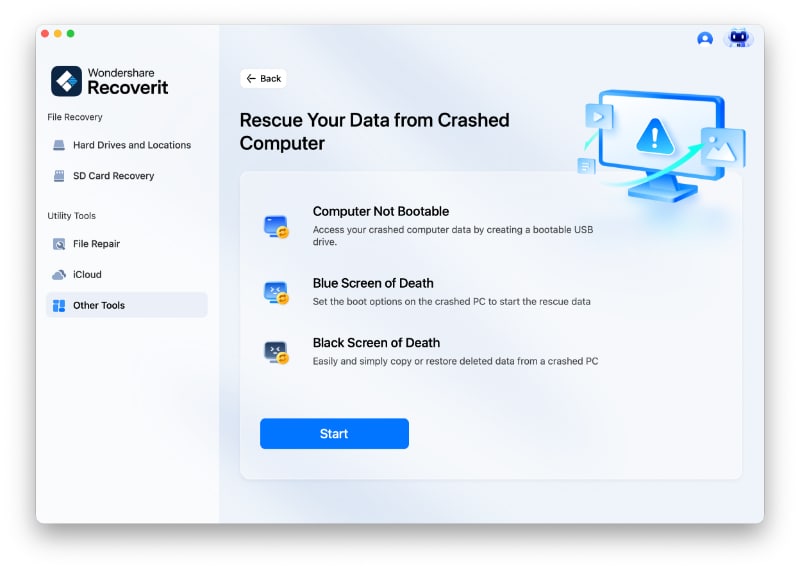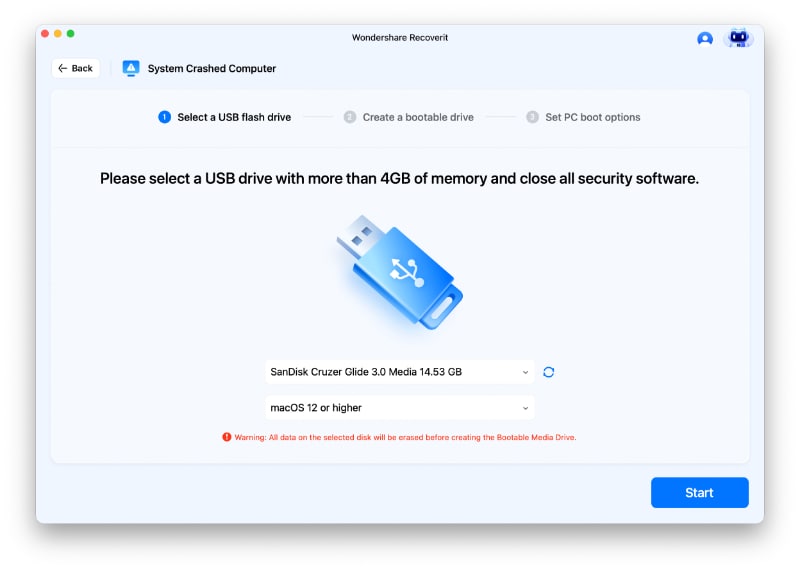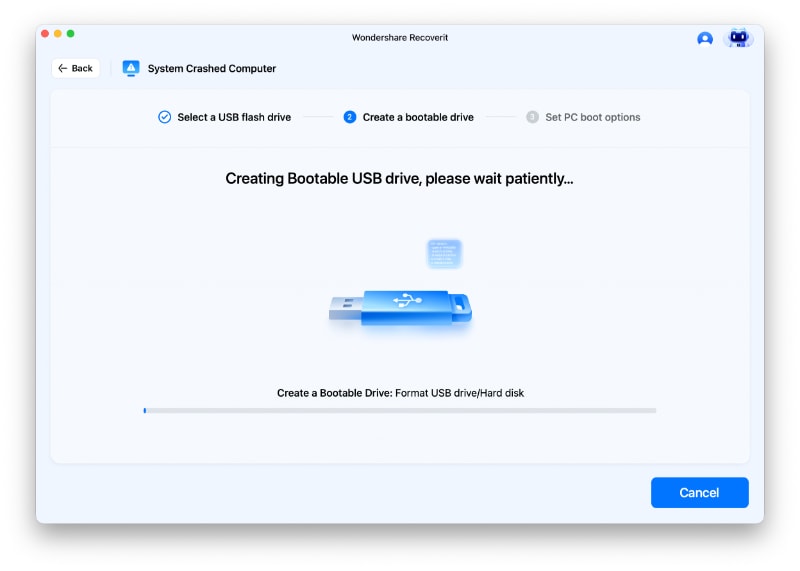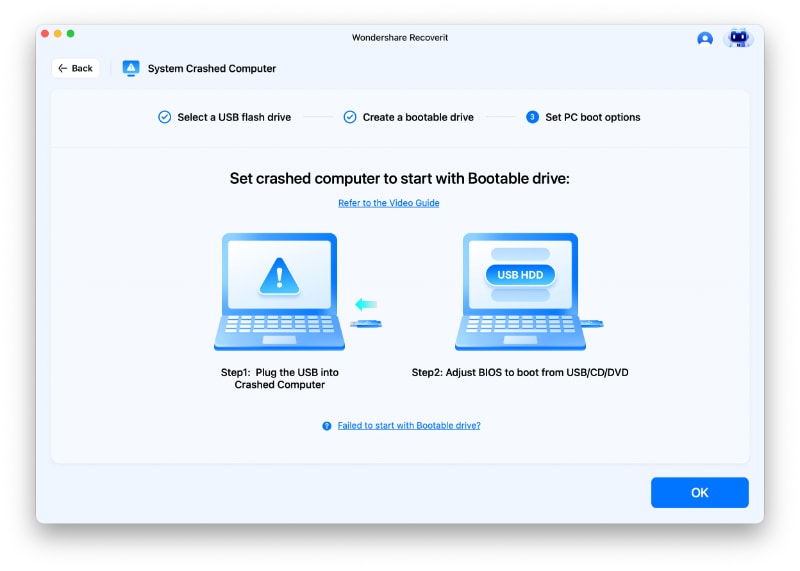Trying to boot your Mac from a USB drive to reinstall macOS or run diagnostics, only to find it doesn't work, is a common frustration. When your Mac won't boot from a USB, it can halt your troubleshooting plans, especially if your main internal drive is having issues. This problem can affect any model, from a MacBook Pro to an iMac.
The good news is that this issue is usually solvable. This guide will walk you through the primary reasons your Mac might fail to boot from an external drive—from incorrect security settings to a poorly created bootable drive—and provide five step-by-step solutions to fix it. We'll also cover how to recover data if your Mac is completely unbootable.
Table of Content
Common Reasons Your Mac Won't Boot From a USB Drive (iMac, MacBook Pro/Air)
There could be several reasons why your iMac or MacBook won't boot from a USB drive. Some are minor issues (e.g., you didn't connect your USB correctly), while others indicate a corrupted USB drive.
These are the most common causes of your Mac not booting from a USB:
- USB drive issues – If your USB has bad sectors or physical damage, or you incorrectly formatted it, you won't be able to use it to boot your Mac.
- Hardware problems – If some of your Mac's components malfunction, booting from a USB won't be possible. That includes issues with RAM, motherboard, hard drive, etc.
- Malware attack – If there's malicious software on your Mac, you'll experience many problems, including the Mac not booting from a USB.
- Incorrect settings – Your Mac won't boot from external devices like USB flash drives if you haven't allowed it to do so.
What To Do if Your Mac Won't Boot From a USB Before Trying the Fixes
Now that we've established the possible causes of your Mac not booting from a USB, it's time to see what you can do before fixing the problem.
1. Verify Your Bootable USB Drive Creation & Boot Process
When your Mac won't boot from a USB, it's important to verify whether the bootable USB has been created correctly and if the booting process has been properly executed. Errors during the creation of the bootable USB or in the booting process can lead to issues preventing your Mac from starting up using the USB drive.
To resolve this, ensure that you have followed the correct steps to create a Mac bootable USB. Additionally, double-check the boot procedure, making sure you have selected the right USB drive as the primary boot source in your Mac's settings by learning how to boot from USB drive on Mac.
2. Check External Drive Connection (USB Ports & Cables)
If your MacBook won't boot from a USB or an external drive, that device might not be corrupted or damaged. The problem could be a bad connection. Thus, before fixing the problem, check if you've connected your USB or hard drive correctly.
3. Retrieve & Back Up Data from Your Unbootable Mac (Essential Step)
Last but not least, it's crucial to retrieve and transfer the data stored on your unbootable Mac to a safe location to prevent data loss. Wondershare Recoverit for Mac is an effective and reliable data recovery tool that can help you accomplish this task. With its user-friendly interface and powerful data recovery capabilities, Recoverit can retrieve a wide range of lost or deleted files, including photos, videos, and documents from various devices like Mac computers, even when they won't boot.
Easily recover deleted or lost files from 2000+ storage devices like HDDs, SSDs, external drivs, USB drives, memory cards, and more. The software confidently retrieves all data types, regardless of how they went missing.
You only need a working Mac, a reliable hard drive, and a blank USB. Once you have those, follow these steps to retrieve data from a Mac that won't boot:
- Download and install Wondershare Recoverit on a working Mac.
- Go to the System Crashed Computer section and click Start.

- Connect your blank USB to your computer. Select the USB and click Start.

- Click Format and wait for the program to finish formatting your USB drive.
- Once the process is complete, the software will start creating a bootable USB drive.

- Once you have a bootable USB, the instructions on the screen will tell you to insert the bootable USB into the crashed MacBook and adjust the BIOS to boot from that USB.

- When you boot your crashed MacBook, connect the external hard drive and select the files you want to recover.
- Choose the hard disk as the destination and click Start Copy.
How to Fix a Mac That Won't Boot From a USB Drive
Even if you've recovered your lost files, checked your drive connection, and correctly created a bootable USB, your Mac still might not boot. If that's the case, try resolving the problem another way.
Fix 1: Format Your USB Drive to GUID Partition Map for Mac Boot
You've created a bootable USB drive and tried booting your Mac, but it's not working. That can happen if your USB flash drive has the MBR partition type. It's a default setting when formatting a USB. However, to ensure your bootable USB works on a Mac, you must format it to GUID Partition Map.
Follow these steps to format your USB drive for Mac:
- Connect the USB drive to your MacBook.
- Press Command + Space and type Disk Utility. Open it.
- Select your USB drive in the left sidebar and click Erase at the top of the screen.

- Set the format to OS Extended (Journaled) and the scheme to GUID Partition Map.
- Click Erase and wait for your USB to finish formatting.
- Once your USB is formatted correctly, you can create a bootable USB again and try it on your Mac.
Fix 2: Allow Mac to Boot from External Devices in Startup Security Utility
Your Mac might not have a problem, and your bootable USB might work correctly. However, your Mac may not be booting from a USB because the settings don't allow it. After all, macOS turns off the option to boot from an external drive by default.
You can enable this option and allow your Mac to boot from USB drive by following these steps:
- Restart your MacBook.
- Press Command + R and release the keys a few seconds after seeing the Apple logo.

- Select the user and type the login credentials.
- Click Utilities and go to the Startup Security Utility.
- Tick the checkbox next to Allow booting from external or removable media.

- Restart your MacBook. When it's turning back on, press and hold the Options key for a few seconds.
- Select a USB to boot your Mac on the Startup Manager screen.

Fix 3: Use Internet Recovery to Reinstall macOS
Older Mac computers don't have a recovery partition. Thus, you must use Internet Recovery if your Mac won't boot using a USB drive. Internet Recovery allows Mac users to install macOS from online Apple servers. This option is valuable for older and newer MacBooks with a damaged recovery partition.
Follow these steps to use Internet Recovery on Intel-based Macs:
- Restart your MacBook.
- Once the computer boots, press Command + Option + R to reinstall the compatible macOS.
Follow these steps to use Internet Recovery on a newer Mac with an M1 chip:
- Turn off your MacBook.
- Press and hold the Power button until you see the screen saying Loading startup options.

- When it loads, select Options and click Continue.

- Follow the prompts and enter Internet Recovery mode.
Fix 4: Reset the SMC (System Management Controller) on Intel Macs
The System Management Controller (SMC) is a security chip that manages crucial components on your Mac. If you can't boot your Mac from a USB, try resetting the SMC. However, Mac computers with an M1 processor don't have the SMC, so you can't reset it on an Apple-silicon Mac.
Follow these steps to reset the SMC on a Mac with a T2 chip:
- Turn off your MacBook.
- Hold the Power button for ten seconds before releasing it.
- Wait another few seconds, then press the Power button again to turn on your MacBook.
Follow these steps to reset the SMC on a Mac without a T2 chip:
- Turn off your MacBook.
- Unplug the power cord.
- Press and hold Shift + Option + Control + Power.

- Hold all the keys for ten seconds, then release them.
- Plug in the power cable and turn on your MacBook.
Fix 5: Reset PRAM/NVRAM to Resolve Mac Boot Issues
PRAM and NVRAM are computer memory types that store specific settings for your MacBook. These small amounts of memory can sometimes malfunction or store corrupted files. That can result in issues with booting your Mac from a USB drive. Thus, resetting PRAM or NVRAM can resolve the problem.
Follow these steps to reset PRAM or NVRAM:
- Turn off your MacBook.
- Press the Power button to turn it back on.
- While it's starting up, press and hold Command + Option + P + R.

- Keep holding these keys until your MacBook restarts. When it's on, your PRAM or NVRAM will be reset.
Why Booting a Mac From USB is Essential (Benefits & Use Cases)
If your MacBook won't turn on, you can boot it from a USB to regain access to your computer. Booting from an external device will help you fix the problem and access your internal disk data. Moreover, booting your Mac from a USB lets you reinstall macOS and get a different OS version.
Besides that, you can also try the new macOS version before installing it on your MacBook. That means booting from a USB lets you safely test the beta version of your chosen macOS. Moreover, you can install older macOS versions and access apps incompatible with newer macOS editions.
Booting your Mac from a USB is easier, faster, and more efficient.
Summary
If you tried booting your MacBook from a USB drive and it won't work, you don't have to worry. That can happen for various reasons, including USB issues, hardware problems, malware attacks, or incorrect settings.
However, before fixing the issue, recover your files with Wondershare Recoverit and check if you've correctly connected the hard drive and created a bootable USB. If yes, you can resolve the problem by formatting the USB, allowing the Mac to boot from the USB, using Internet Recovery, resetting the SMC, or resetting PRAM or NVRAM.
FAQs
-
Why won't my new M1/M2/M3 Mac boot from a USB drive?
Modern Macs with Apple Silicon have a high-security default setting that prevents booting from external media. To fix this, you must boot into Recovery Mode, open the "Startup Security Utility," and change the security policy to "Medium Security" to allow your Mac to boot from an external drive. -
I'm holding the Option (⌥) key, but my bootable USB doesn't appear. Why?
This usually means the USB drive was not created correctly. Ensure it was made using Apple's createinstallmedia command in Terminal and is formatted as Mac OS Extended with a GUID Partition Map. A faulty USB drive or adapter could also be the cause if your MacBook Pro won't boot from USB. -
Can a bad USB port cause this issue?
Absolutely. A faulty port can prevent your Mac from recognizing the drive at startup. If your MacBook Air won't boot from a USB, try using a different port on the device. Also, verify the USB drive works on another computer to rule out a problem with the drive itself. -
My Mac shows a prohibitory symbol when I try to boot from the USB. What's wrong?
The prohibitory symbol (a circle with a slash) means the macOS version on your USB installer is not compatible with your Mac hardware. This often happens if you try to install a version of macOS that is older than the one your Mac originally shipped with.



 ChatGPT
ChatGPT
 Perplexity
Perplexity
 Google AI Mode
Google AI Mode
 Grok
Grok























